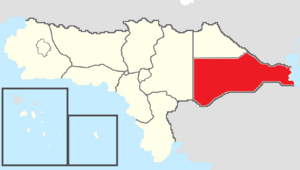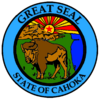Cahoka
This article is incomplete because it is pending further input from participants, or it is a work-in-progress by one author. Please comment on this article's talk page to share your input, comments and questions. Note: To contribute to this article, you may need to seek help from the author(s) of this page. |
State of Cahoka | |
|---|---|
State | |
| Nickname(s): The Sunrise State (official) The Big State | |
| Motto: | |
 Map of Rizealand with Cahoka in red | |
| Country | |
| Before Statehood | Eastern Territory |
| Capital | Cahoka City |
| Largest city | Gadsen |
| Joined Federation | February 15, 1905 (8th) |
| Government | |
| • Governor | Roy Lamb (TNC-CRP) |
| • Deputy Governor | Amy Butler (TNC-CRP) |
| • Legislature | Cahoka State Assembly |
| • Federal representation | Councilors
|
| Area | |
| • Total | 325,264.91 km2 (125,585.48 sq mi) |
| Population (2021) | |
| • Total | 3,824,043 |
| • Density | 11.76/km2 (30.5/sq mi) |
| Time zone | UTC+10 to +11 (Central/Eastern) |
| Abbreviation | CA |
| ISO 3166 code | RZ-CA |
| Website | www |
Cahoka, known officially as the State of Cahoka, is a state in eastern Rizealand that is bordered by the Powhatan Nation to the northwest, Cassier to the northeast, Lake Weanoke and Chistovodia to the east, Marchenia to the south, and Lyhoming to the west. Cahoka has a total area of 325,264.91 square kilometers, making it the largest state and political division of Rizealand. Cahoka also has a population of 3,824,043, making it the sixth most populous state and political entity in Rizealand. Cahoka's capital city is Cahoka City and its largest city is Gadsen.
Etymology
The "State of Cahoka" is named after the ancient Nimarew city of Cahoka near present-day Cahoka City in the center of the state. The ancient city of Cahoka was also called "El Dorado" and was rumored to be a city made out of gold. More recent archeological excavations however have determined that Cahoka was not a golden city but was a major trading, cultural, political, and economic center for the Nimarew in eastern Rizealand.
Geography
Ecology
Climate
Conservation
Demographics
Population
Language
Religion
Health
Education
Urban Areas
Government and politics
The government of Cahoka is established and organized according to the Constitution of Cahoka. Because Cahoka is a constituent state of Rizealand, the powers of its government are subject to certain limits by the Articles of Federation including the requirement of a democratic form of government and prohibitions on forming alliances with foreign governments, declaring war, raising or maintaining armies, establishing forms of currency, and placing unlawful restraints on interstate and international trade. In addition to constitutional restraints on state power, the Articles also allow the Central Assembly to enact legislation that can supersede state laws when involving national security, interstate commerce, foreign affairs, immigration, and the public's welfare. Like the federal government of Rizealand, the government of Cahoka is divided into three branches of government.
The legislative branch consists of a unicameral State Assembly. The State Assembly's 45 seats are filled through closed party list proportional representation elections held every three years. As the state legislature, the State Assembly is responsible for enacting legislation and can do so with a simple majority, although a majority of two-thirds is required to override the Governor's veto, enact super laws, or remove government officials from office. The State Assembly is also responsible for approving the Governor's executive nominations.
The executive branch is headed by the following constitutional officers elected in statewide two-round direct elections at the same time as the State Assembly for three-year terms, with a limit of two consecutive terms.
- The Governor is the head of state and government responsible for signing legislation into law, nominating executive agency heads, appointing state judges, and enforcing the laws of the state.
- The Deputy Governor assists the Governor in carrying out his duties and becomes governor if the office falls vacant.
- The Attorney General is the chief legal officer of the state and is responsible for issuing formal opinions, enforcing state laws via the courts, representing the state in court, and overseeing all criminal prosecutions.
- The Public Safety Commissioner is the chief law enforcement officer of the state responsible for the oversight and command of state law enforcement agencies.
- The State Treasurer is the chief banker and investment officer responsible for managing state revenue, overseeing state budgets, and providing an accounting of the state's finances.
- The Education Commissioner is responsible for the oversight of the state's public school system and education services, as well as the disbursement of education funding
- The Drilling and Mining Inspector is responsible for the safety, oversight, and regulation of mining, oil drilling, and natural resource extraction
- The Commerce commissioners are responsible for the regulation of public utilities, enforcement of state antitrust laws, and registration of corporations in Cahoka.
The judicial branch consists of the High Court, Court of Appeals, Superior Court, justice courts, and municipal courts. Justices and judges of the High Court, Court of Appeals, and Superior Court are nominated by the Cahoka Judicial Nominations Council and appointed by the Governor for a lifetime term, subject to retention elections every six years. Justices of the peace are elected in two-round direct elections for six-year terms and magistrates of municipal courts are appointed in a matter determined by each municipal government.
There are also independent agencies and commissions established by the state constitution or state super laws that do not neatly fit into any branch of government, as they often enforce state laws (executive), issue rules and regulations (legislative), and adjudicate cases or claims (judicial). While their agency heads or commission members are usually nominated or appointed by the Governor, they can only be removed from office through impeachment and removal by the State Assembly.
Cahoka has a common law legal system with some Estmerish influences. In addition to the protections of the Articles of Federation, the Cahoka Constitution also establishes additional protections and gives citizens the right to recall state officials, refer legislation to a referendum vote, enact legislation via an initiative vote, and approve amendments to the state constitution.



